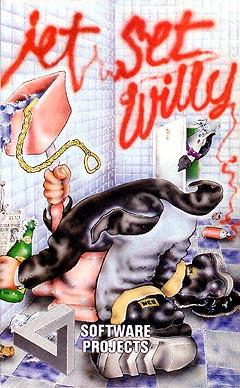
Jet Set Willy
Jet Set Willy is a platform video game written by Matthew Smith for the ZX Spectrum home computer. It was published in 1984 by Software Projects and ported to most home computers of the time.
Jet Set Willy
- Software Projects
- Tynesoft (Atari)
Rob Hubbard (Atari)
- 1984: ZX Spectrum, Commodore 64
- 1986: Atari 8-bit
- 2012: Xbox 360[1]
The game is a sequel to Manic Miner published in 1983, and the second game in the Miner Willy series. It spent over three months at the top of the charts and was the UK's best-selling home video game of 1984.[2]
The player controls Miner Willy as he tidies up his mansion after a massive party to get some sleep. Players navigate Willy through 60 screens of the mansion and grounds, collecting glowing items while avoiding hazards and guardians.
The game features classical music from Beethoven, Grieg, Bach, and Mozart. Initially the game could not be completed due to various bugs, but fixes for these were released by Software Projects. Jet Set Willy included a copy protection measure in the form of a card with coloured codes, making it more difficult to duplicate. Various expanded versions and ports were released, as well as third-party editing tools that allowed players to design their own rooms and sprites.
Plot[edit]
A tired Miner Willy has to tidy up all the items left around his house after a huge party. With this done, his housekeeper Maria will let him go to bed. Willy's mansion was bought with the wealth obtained from his adventures in Manic Miner, but much of it remains unexplored and it appears to be full of strange creatures, possibly a result of the previous (missing) owner's experiments. Willy must explore the enormous mansion and its grounds (including a beach and a yacht) to fully tidy up the house so he can get some much-needed sleep.
Copy protection[edit]
Jet Set Willy came with a form of copy protection: a card with 180 coloured codes on it was bundled with the cassette. Upon loading, one of the codes from the card had to be entered before the game would start. Although the cassette could be duplicated, a copy of the card was also needed and at the time, home colour reproduction was difficult,[14] making Jet Set Willy harder to copy than most Spectrum games, but means of circumventing the card were quickly found, and one method was published in a UK computer magazine.[15]
Legacy[edit]
Expanded versions[edit]
Jet Set Willy: The Final Frontier, an expanded version for the Amstrad CPC, was later converted back to the ZX Spectrum and released as Jet Set Willy II.[22] Both the original game and Jet Set Willy II were released for the BBC Micro, Acorn Electron, MSX, Commodore 16 and Commodore 64.
A differently expanded version of Jet Set Willy was released for the Dragon 32/64, with extra rooms.[23] This version could also not be completed as it was impossible to traverse The Drive in a right-to-left direction, which was necessary to return to bed after collecting all the items. The game could, however, be completed using a built-in cheat, accessed by holding down the keys M, A and X simultaneously, allowing the player to start Willy from any position on any screen, using the arrow keys and spacebar.
The Dragon port was itself converted to run on the Acorn Archimedes computers. Better collision detection meant that "The Drive" could now be completed right-to-left, unlike on the Dragon.[24]
Third-party modifications[edit]
In its original Spectrum version, the rooms themselves are stored in a straightforward format, with no compression, making it relatively easy to create customised versions of the game.
The review of JSW in issue 4 of Your Spectrum included a section entitled "JSW — A Hacker's Guide"; remarks in this section imply that the author had successfully deduced at least some of the data structures, since he was able to remove sections of wall in the Master Bedroom.[7] The following year, issue 13 contained a program that added an extra room ("April Showers") to the game,[3][25] and issue 15 described the data formats in detail.[26]
Several third-party editing tools were published between 1984 and 1986, allowing players to design their own rooms and sprites.
The following platform games are in the same mould as the Miner Willy series with the purpose of the game being to collect objects to complete the scenes in the game: